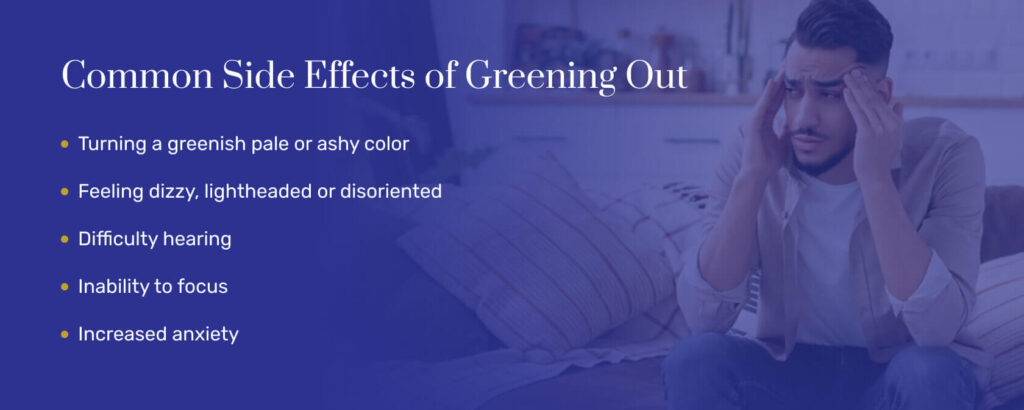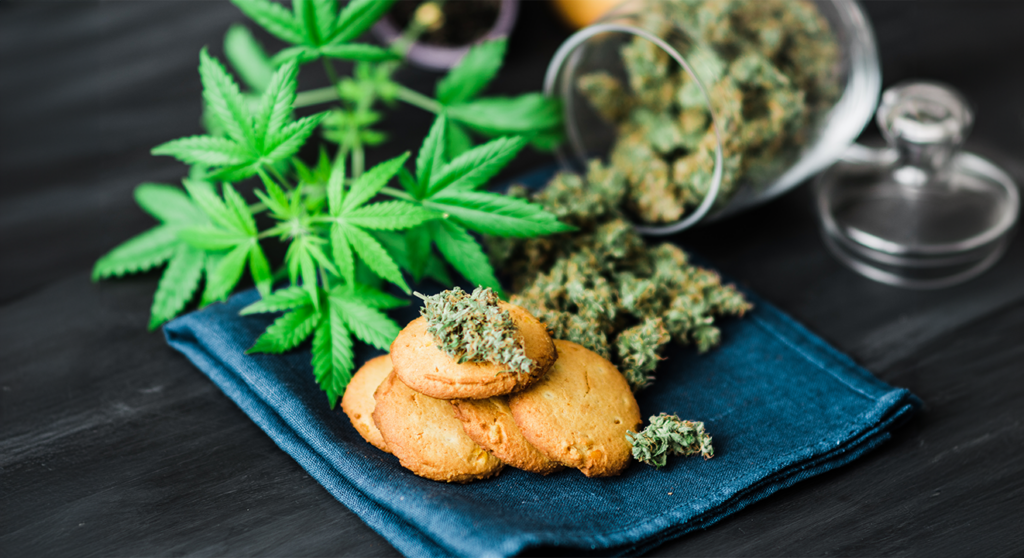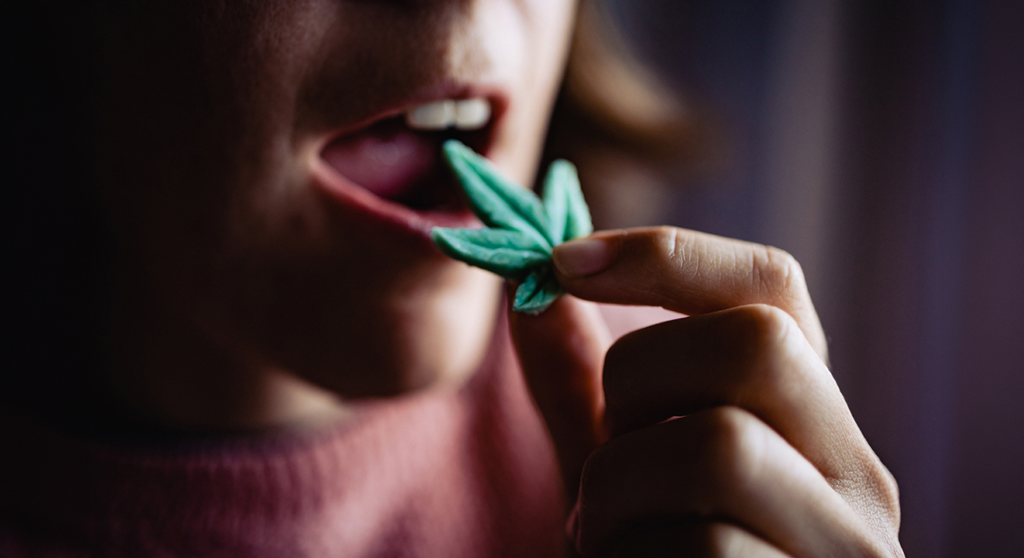No pill, injection, or medication can treat someone who is greening out. But supportive care and monitoring can ensure that the person stays safe while the body processes remaining marijuana.
What Is Greening Out?
Quick Answer
Greening out is a marijuana overdose. The Centers for Disease Control and Prevention says a fatal overdose caused solely by marijuana is unlikely, but symptoms can be severe.[1]
People use the term greening out when discussing a marijuana overdose. Greening out can be caused by the following:
Are you or someone you know struggling with addiction?
I may have a problem I am concerned for a loved one- Ingestion: Eating large amounts of marijuana flower or THC-infused products can cause a greenout.
- Vaping: THC vape cartridges can lead to greening out.
- Trying new marijuana products: Using cannabis concentrates like shatter, wax, oil, and butter can also lead to greening out, as these products are generally far more potent than actual cannabis flowers. Sativa, indica, and hybrid strains can all cause greening out when overused.
- Mixing: Using marijuana with alcohol and other drugs (also referred to as crossfading) can also lead to greening out.
Key Facts About Greening Out
Key Facts
- Greening out is a synonym for marijuana overdose.
- About 2.5% of the world’s population uses marijuana.[2]
- Mixing marijuana with other substances (including alcohol) can lead to increased sedation and impairment than using either substance alone.[1]
- Between 2006 and 2014, emergency department visits spurred by marijuana increased 12.1% per year.[3]
Causes of Greening Out
Your brain and body are loaded with cannabis receptors. Doses latch to them, triggering chemical reactions that alter your perception, feelings, and more. Take too much marijuana, and your experiences will become overwhelming or unpleasant.
Some people experience greenouts due to the effects of marijuana. They take too much or use doses too close together, and they develop symptoms.
Mixing alcohol and marijuana can also lead to a greenout. Combining two drugs with sedating properties can overwhelm your central nervous system and cause unpleasant side effects. If you’re experiencing issues related to alcohol and marijuana use, our Indiana addiction treatment center provides structured support to help you stabilize safely.
Side Effects & Symptoms of Greening Out
A marijuana overdose causes recognizable signs and symptoms. Knowing what they are can help you provide help to someone in need.
People who are greening out often develop these symptoms:
- Turning a greenish pale or ashy (probably where the term greening out comes from)
- Becoming dizzy and lightheaded
- Losing mobile functions (feeling like your arms and legs are too heavy to move)
- Becoming disoriented with blurry vision
- Unstable balance
- Trouble hearing
- Losing the ability to focus
- Mildly hallucinating
- Increased anxiety, unease, paranoia, or panic attacks
- Decreased blood sugar
- Increased heart rate

THC in marijuana rose from 3.96% in 1995 to 15.34% in 2021.[4] Higher THC potency is directly related to your risk of greening out.
National Institute on Drug Abuse
What to Do if You or Someone You Know Is Greening Out
If you or a loved one are struggling with marijuana addiction help is available – take the first step toward recovery today.
If you or someone you love is currently greening out, call 911 immediately. Tell the operator what’s happening, and follow the instructions carefully.
If the operator doesn’t recommend going to a hospital or urgent care center, you can help someone recover. Follow these steps:
Stay calm: Don’t yell, scream, or otherwise aggravate an already stressful situation. Use a low voice and gentle touch to help the person stay grounded and still.
Offer water: Encourage the person to stay hydrated. Drinking water can also help to flush toxins from the body.
Provide a snack: If the person is queasy, a mild snack (like a piece of toast) may help.
Remain available: Don’t leave the person alone until the symptoms fade.
Preventing a Green Out
The best way to prevent greening out is to stop using marijuana products. When you’re sober, you’re no longer at risk.
If you aren’t ready to quit, try the following steps:
Use the same type of product
Don’t switch from smoking to edibles and back to smoking.
Buy from the same place:
Ask how much THC is in your products before you take them.
Wait between doses
Don’t take more marijuana because you can’t feel the effect of the first hit.
Don’t mix
Avoid alcohol and other drugs while you’re using marijuana.
Marijuana overdose is closely related to edible products, says the Centers for Disease Control and Prevention. It can take up to two hours to feel the effects of these drugs.[1]
Centers for Disease Control and Prevention
Risks of Marijuana Overdose
Any marijuana product can cause greening out if you take too much of it. But understanding the risks and dangers of the types of drug you use could help you limit your risks.
Know that any amount of marijuana can cause problems. Even small doses can put great strain on your heart. Some people develop hallucination-type disorders after using marijuana. While THC can cause an overdose, it can trigger other health issues too.


Signs of Marijuana Abuse
Method of Ingestion
The forms of marijuana you use are closely related to your overdose risk. Whether you smoke or vape marijuana flowers, or you use dabbing or edibles, you can overdose.
Understanding when you’ll experience side effects and how long they last can help you space your doses properly.
| Mode of Consumption | How Soon to See Effects | Length of Effects |
|---|---|---|
| Smoking/vaping | 2–10 minutes | 1–3 hours but can last up to 8 hours |
| Edibles | 30–60 minutes | 24 hours |
| Dabbing | Instantly | 1-3 hours |
Signs You Might Have a Problem With Marijuana Use
Marijuana abuse and addiction are possible. Signs that a person may have cannabis use disorder include the following:
- Overconsumption of marijuana products
- Using cannabis products frequently
- Combining cannabis products with other drugs and medication
- Engaging in drug-seeking behavior
- Spending less time with friends and family to use marijuana
- Lack of interest in things that aren’t related to marijuana use
- Increased tolerance to cannabis products
Getting Help for Marijuana Addiction
Treatment options for marijuana addiction may include an initial detoxification period combined with either inpatient or outpatient rehabilitation services.
Quitting marijuana alone is difficult. Some people try tapering approaches, using a little less every day until they’re taking none. But others relapse to drug use when their symptoms grow too severe. Marijuana detox programs can offer a safe space to get sober, free from outside temptation.
After detox, treatment begins. Inpatient treatment isn’t common for marijuana addiction, but it may be recommended if you’re struggling with long-term or severe addiction. It may also be advised if you’re dealing with other mental health issues (like schizophrenia) in addition to marijuana addiction.
Support groups often provide vital assistance for those dealing with marijuana addiction. Some people may begin their recovery in support group meetings, like 12-step meetings. Others use them as an important source of aftercare after more intensive treatment is completed.
Different forms of therapy are available to treat marijuana addiction, including cognitive behavioral therapy (CBT) and acceptance and commitment therapy. Many individuals who suffer from marijuana addiction also benefit from family therapy and group therapy.
Talk to your treatment providers about the right approaches for your specific situation. For the best results, addiction treatment should be tailored to the needs of the individual, and it should change as the person grows and progresses in recovery. If you’re seeking structured, compassionate support, our Indiana addiction treatment center offers individualized care for marijuana addiction, co-occurring disorders, and long-term recovery planning.
Frequently Asked Questions About Greening Out
We’ve compiled some of the most frequently asked questions about greening out.
It varies, but people who go to the emergency room due to marijuana overdose typically need treatment and observation for 24 hours.[2]
Greening out feels like very intense marijuana intoxication combined with physical sickness (like nausea). It’s deeply uncomfortable.
Call the poison control center and ask for instructions. If you’re not asked to go to the emergency room or an urgent care clinic, stay with the person and offer fluids, snacks, and companionship.
The National Institute on Drug Abuse has no record of someone dying due to a marijuana overdose.[5]
Most people feel better within a day or so, but you shouldn’t return to marijuana use immediately. Give your brain and body time to heal. If you have a problem with marijuana addiction, reach out for help.
- Marijuana and public health: Frequently asked questions. Centers for Disease Control and Prevention. Published June 11, 2021. Accessed June 21, 2023.
- Turner AR, Spurling BC, Agrawal S. Marijuana toxicity. [Updated 2023 Feb 12]. In: StatPearls [Internet]. Treasure Island (FL): StatPearls Publishing; 2023 Jan-.
- Roehler DR, Hoots BE, Holland KM, Baldwin GT, Vivolo-Kantor AM. Trends and characteristics of cannabis-associated emergency department visits in the United States, 2006-2018. Drug Alcohol Depend. 2022;232:109288.
- Cannabis potency data. National Institute on Drug Abuse. Published November 23, 2022. Accessed June 21, 2023.
- Drug overdose death rates. National Institute on Drug Abuse. Published February 9, 2023. Accessed June 21, 2023.















